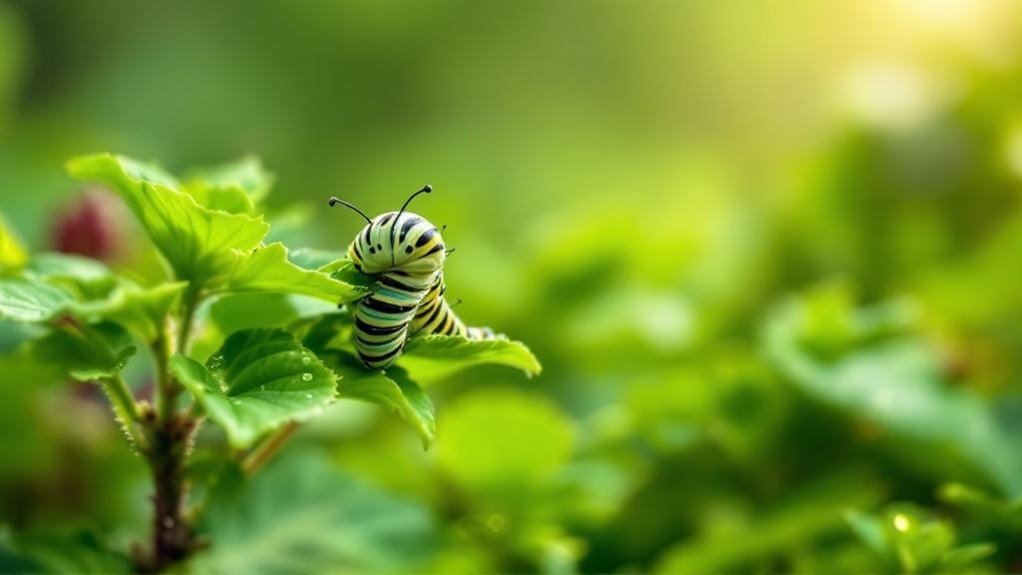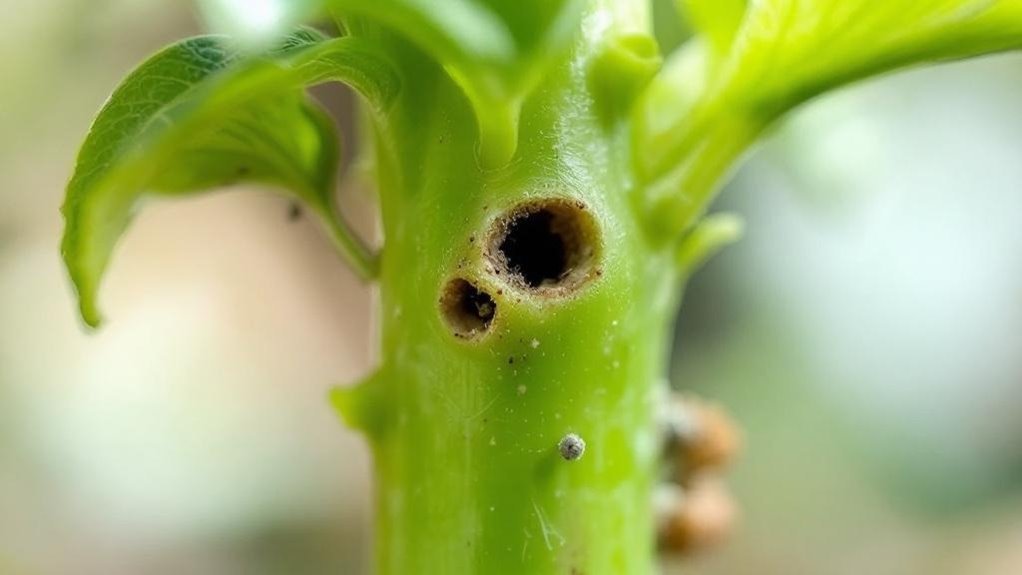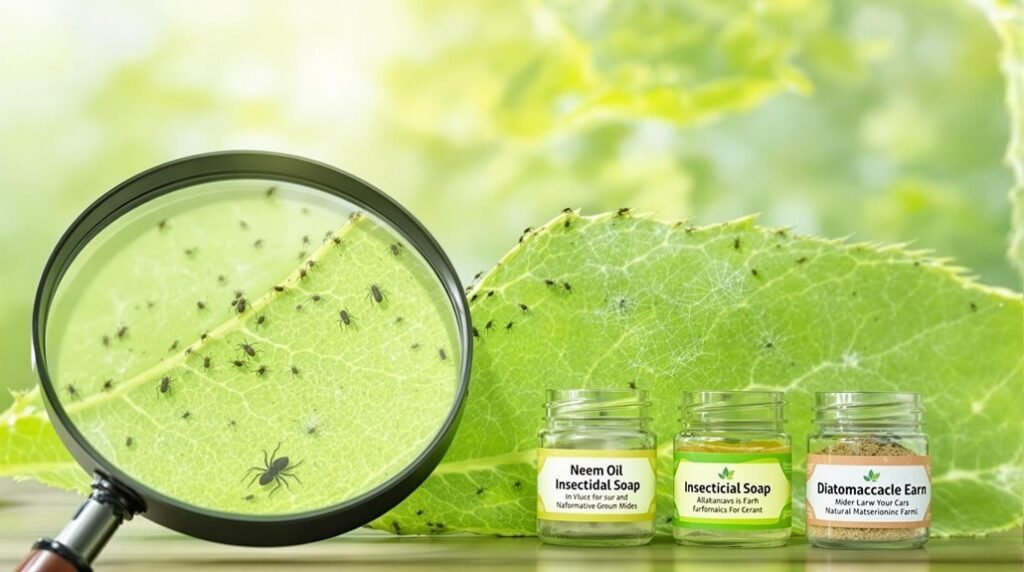When you spot unusual damage on your plants, knowing exactly which pest is responsible can make all the difference in how you respond. Misidentifying a threat might lead you to use unnecessary chemicals or overlook beneficial insects that actually help keep your garden healthy. Understanding how to spot common caterpillars, beetles, borers, and smaller pests will empower you to take targeted action, but it’s only the beginning of effective plant care.
Importance of Accurate Pest Identification
Although pests can look very different at various stages of their life cycle, accurately identifying them is essential for effective management.
When you focus on proper pest identification, you avoid mistaking beneficial insects for harmful pests, which helps protect your garden’s natural ecosystem. Knowing exactly which pest you’re dealing with lets you decide if it’s a temporary visitor or a real threat that demands action. This way, you prevent wasting time and resources on unnecessary treatments.
Proper pest ID protects beneficial insects and saves time by targeting only real threats.
To get pest identification right, rely on trustworthy sources like university extension services or government publications. You can also seek expert help, which reduces the risk of applying pesticides unnecessarily and supports sustainable gardening practices.
Accurate pest identification is your first step toward effective, eco-friendly garden care.
Identification of Beneficial Insects in the Garden
Knowing which insects help your garden can be just as important as identifying pests. Beneficial insects like ladybugs, parasitic wasps, and green lacewings play an essential role in naturally controlling harmful pest populations.
You’ll spot ladybugs on plants infested with aphids, whiteflies, or mealybugs since they feed on these pests. Parasitic wasps are drawn to flowers from the daisy and dill families, where they lay eggs inside aphids and caterpillars, reducing their numbers.
Green lacewings thrive in gardens filled with diverse flowering plants, feeding on aphids and other small pests. To encourage beneficial insects, provide a variety of flowering plants and water sources.
This not only supports ecological balance but also lessens your reliance on chemical pesticides, keeping your garden healthier overall.
Common Caterpillar Pests and Their Control

Caterpillar pests can quickly damage your garden, especially when they target key plants like tomatoes, cabbage, and corn. Managing these common insect pests involves a mix of biological controls and physical removal. Bacillus thuringiensis (Bt) is a powerful, natural option that targets many caterpillars without harming beneficial insects. Introducing or encouraging predators also helps keep populations down. Here’s a quick guide to some common caterpillar pests and their best control methods:
| Caterpillar Pest | Control Methods |
|---|---|
| Tomato Hornworm | Bt, handpicking, beneficial insects |
| Codling Moth | Beneficial insects, clean fallen fruit |
| Cabbageworm | Bt, row covers |
| Cabbage Looper | Bt, beneficial insects |
| Corn Earworm | Bt, mineral oil on corn silk |
Use these strategies to protect your plants effectively.
Beetle Pests and Effective Management Techniques
Five common beetle pests can wreak havoc on your garden, but you can manage them effectively with the right techniques.
The Colorado Potato Beetle resists many insecticides, so catch it early and handpick to protect your crops.
Catch the Colorado Potato Beetle early and handpick to protect your crops from this resistant pest.
Cucumber Beetles spread bacterial wilt; use row covers and pyrethrins to keep them at bay.
For Japanese Beetles, handpicking and applying milky spore to the soil reduce larvae and protect over 300 plant species.
Mexican Bean Beetles respond well to beneficial insects like ladybugs and manual removal of their eggs and larvae.
Don’t overlook Flea Beetles; apply diatomaceous earth and neem oil, plus row covers, to shield young plants.
With vigilance and these targeted methods, you’ll keep beetle pests under control.
Recognizing and Controlling Borers in Plants

Borers like the Squash Vine Borer and Peach Tree Borer can seriously damage your plants by tunneling into stems or trunks, often causing decline or death if left unchecked.
To recognize these pests early, watch for wilting and frass, which looks like sawdust. The European Corn Borer is another major pest affecting crops like corn.
You can control borers by manually removing them or using beneficial nematodes. Applying Bacillus thuringiensis (Bt) before borers enter plants is a proven preventive method.
Keep your plants healthy with proper watering and nutrients to boost their resistance against pests. Regularly inspecting your plants will help you catch infestations early, making control efforts more effective and protecting your garden from serious damage.
Identification and Treatment of Small Insect Pests
While small insect pests might seem minor, they can quickly weaken your plants by sucking sap and distorting foliage.
Aphids often hide on leaf undersides, but you can control them by introducing ladybugs or spraying with a strong water jet to knock them off.
Aphids hide beneath leaves—use ladybugs or a strong water spray to easily control them.
Thrips, which cause a stippled look on leaves, require isolating affected plants and applying insecticidal sprays.
Spider mites leave silky webs and thrive in dry, hot conditions; treat them with specific insecticides, repeating applications as needed.
Mealybugs, covered in wax, respond well to manual removal and treatments using insecticidal soap or neem oil.
Regularly check your plants for signs of these pests to catch infestations early and keep your garden healthy and thriving.
Identification and Control of True Bugs
Because true bugs have piercing mouthparts and a distinctive X-shaped pattern on their backs, they can cause significant damage by sucking nutrients from your plants.
This plant pest group includes squash bugs, tarnished plant bugs, and stinkbugs, each targeting different crops like squash, soft fruits, and tomatoes.
To control squash bugs, use pyrethrins and row covers to prevent infestation.
Tarnished plant bugs respond well to beneficial insects and early pyrethrin applications before flowering.
For stinkbugs, managing weeds around your garden and applying insecticidal soap on nymphs helps reduce damage.
Regularly monitor your plants for signs of these pests and act quickly.
Early intervention is key to minimizing harm and protecting your garden’s health and yield from these destructive true bugs.
Frequently Asked Questions
How to Identify Pests on a Plant?
You can identify pests by checking leaves for spots, holes, or discoloration. Look under leaves for webbing, sticky residue, or tiny insects. Use a magnifying glass to spot small pests and catch infestations early.
What Bug Is Killing My Plants?
You’ll want to closely inspect your plants for signs like leaf curling, discoloration, or webbing. Identifying visible bugs, such as aphids or spider mites, helps you determine which pest is harming your plants.
How to Get Rid of Brown Scale on Plants?
You spot the brown scale, small yet stubborn; you act quickly, wiping them off with alcohol. Then, you treat plants with neem oil, repeating every week or two, keeping your greenery healthy and pest-free.
What Can I Spray on My Plants to Keep Pests Away?
You can spray neem oil, insecticidal soap, or pyrethrin on your plants to keep pests away. Crucial oils like peppermint or rosemary also work well and are safe for most plants and beneficial insects.
Final Thoughts
Now that you know how to spot pests and tell beneficial insects apart, are you ready to protect your garden the smart way? By regularly inspecting your plants and using targeted, eco-friendly treatments like Bt or handpicking, you’ll keep harmful pests in check without harming helpful bugs. Remember, healthy plants resist pests better, so caring for them well is key. Why not start applying these simple, effective strategies today?
